Physical and chemical properties of soil
Maps 5.07–5.16 display measures of the physical and chemical properties of soils in Namibia. The explanations around these characteristics are often quite technical, but the properties are all important in determining the fertility of a soil.
5.07 Soil texture

Soil texture reflects the relative proportions of differently sized particles in a soil. Once the percentages of sand, silt and clay particles are known, the combined soil texture can be read from a texture triangle. For example, a soil with 20 per cent clay, 45 per cent silt and 35 per cent sand has a loamy texture. Soil texture governs soil-forming processes, soil structure, waterand nutrient-holding capacities, drainage characteristics and workability. Medium-textured soils – such as loam, clay loam, sandy clay loam, silty clay loam, sandy loam and silty loam – are best for most crops. Lightly textured soils – such as sand and loamy sand – have poor water-holding capacity and usually low cation exchange capacity. Thus, they are poor in nutrients. The heavily textured soils – such as clay, sandy clay and silty clay – may cause waterlogging and poor root development, but are usually rich in nutrients.
The great majority of soils in Namibia have sandy and/or loamy textures. High clay contents are found only in alluvial soils along the major rivers of the northeast.

Photo: MAWLR, Agro- Ecological Zoning Programme

Photo: MAWLR, Agro- Ecological Zoning Programme
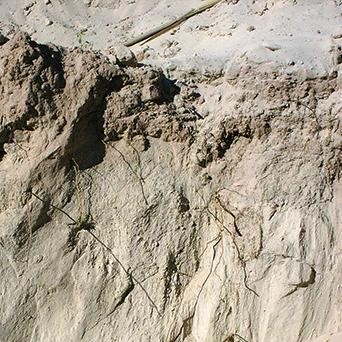
Photo: M Coetzee
Arenosols cover over a third of Namibia, but not all are the same. Some have quartz grains coated with a reddish iron oxide mineral called haematite, indicating good internal aeration and drainage (first photo above); others have quartz grains coated with the yellowish brown mineral goethite, indicating somewhat longer periods of moisture in the soil (second photo above); while those in the last photo have uncoated pale grey quartz grains, indicating advanced leaching.
5.08 Percentage of clay in the soil

Clay particles are products of chemical weathering of parent rock material. They are very small and can remain suspended in water for hours, even days. Clay soils are usually fertile because they retain moisture and nutrients as a result of their large surface-to-volume ratio. However, they are poorly aerated and tend to become waterlogged, and plants may have difficulty absorbing water held in the tiny pores between clay particles.
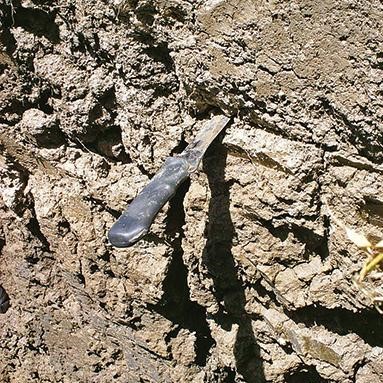
Photo: M Coetzee
Clayey soils can be very hard when dry and sticky when wet, making them difficult to cultivate. However, the same properties make clays suited to pottery.
5.09 Percentage of silt in the soil

Silt particles are formed by the physical weathering of rocks by water, wind and ice. They feel smooth, like talc, when dry, but slick and silky when wet. Individual particles are too small to see with the naked eye. Silty soils are among the best agricultural soils, being easy to cultivate, fertile and having good water-storage potential. They are highly susceptible to erosion, however.
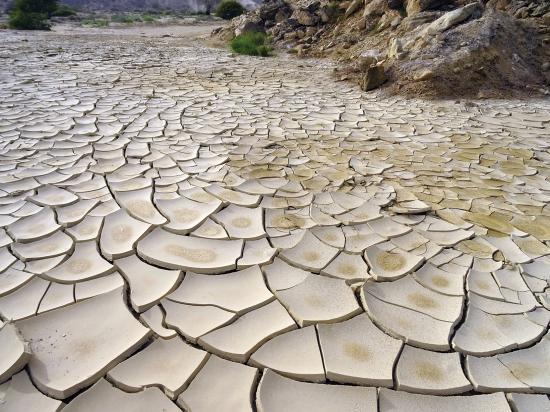
Photo: J Mendelsohn
Sheets of dry silt often crack, creating attractive slabs.
5.10 Percentage of sand in the soil
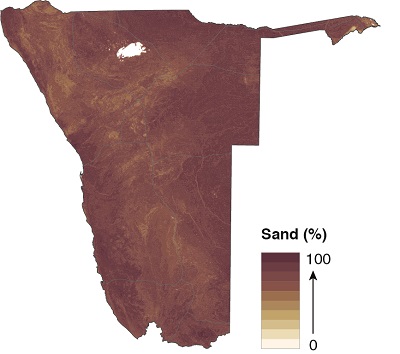
Sandy particles are large enough to be distinguished by the naked eye. They feel and sound gritty when rubbed between the fingers. The minerals, such as quartz, that form sand particles are highly resistant to both physical and chemical weathering. There are large pores between the particles of sandy soils that allow fast infiltration of water and good internal drainage and aeration, but they dry out quickly and store few nutrients. Large parts of Namibia are under sandy soils, the Arenosols.
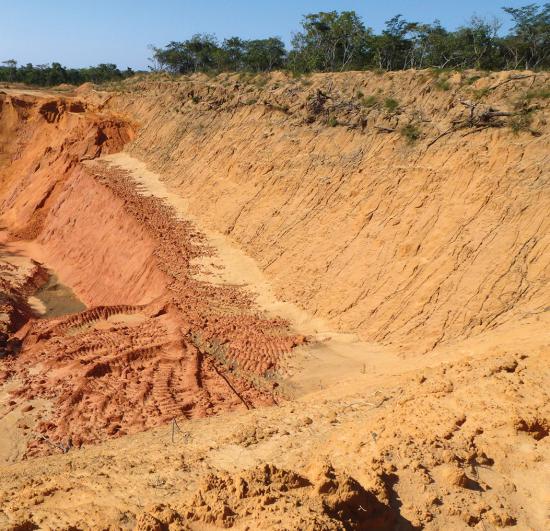
Photo: J Mendelsohn
Deposits of windblown sand may be tens – even hundreds – of metres deep.
5.11 Soil depth
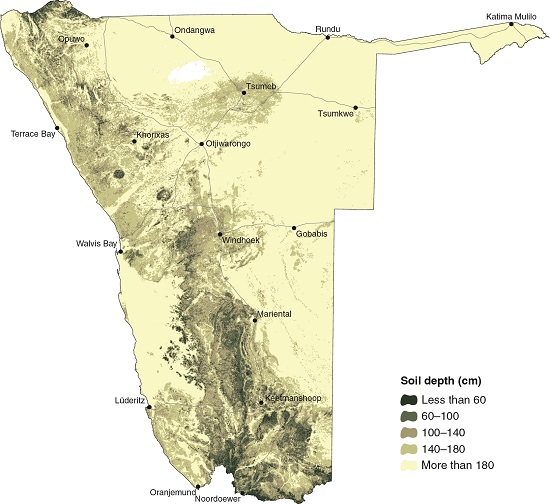
Deeper soils can generally store more water and nutrients and provide better conditions for root growth than shallow soils. Soil depth is not only limited by the presence of shallow bedrock, but also by impermeable layers within the soil. For example, natural chemical processes can cement soil with the formation of calcium carbonate (calcrete) or calcium sulphate (petrified gypsum). Agricultural practices – such as livestock trampling or the use of heavy machinery on wet soil – can compact the soil to form hardpans that hamper or prevent root growth, and in effect limit the depth of the soil. In sandy soils in an arid climate, a cemented layer at some depth can be an advantage, as it impedes drainage and allows more moisture to be stored in the upper layers within the reach of roots.
5.12 Bulk density of soils

The bulk density of a soil is its dry weight in relation to volume, and is largely determined by its texture, porosity, type and degree of soil structure development. This reflects the soil's ability to provide structural support for plants and habitats for soil organisms, and the extent to which it allows the movement of air, water and dissolved substances. In good humus-rich topsoil with a well-developed crumb structure, about half of the soil's volume consists of macropores (visible to the naked eye and allowing good aeration and free drainage of water) and micropores (microscopic and retaining capillary water). Soils with a bulk density of less than 1.5 tonnes per cubic metre (t/m3) allow effective movement of air and water. Bulk density is also an indicator of soil compaction caused by livestock trampling, heavy machinery or inappropriate ploughing methods.
5.13 Soil pH3
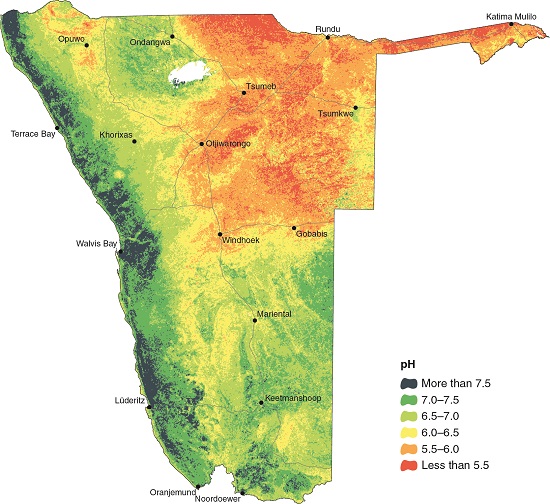
Potential of hydrogen – or pH as it is known – expresses the concentration of hydrogen ions in the soil solution on a scale from 1 (extremely acidic) to 14 (extremely alkaline). Most soils fall in the range of 3–8, and most plants prefer neutral conditions (pH 6–7). The ability of plants to take up calcium, magnesium, nitrogen, phosphorus, boron and molybdenum is suppressed in acidic soils. Acidic conditions promote aluminium toxicity and also slow down the release of minerals from organic matter and nitrification and nitrogen fixation processes. In highly alkaline soils, plants also have difficulty absorbing nitrogen, phosphorus and boron, as well as iron, copper, zinc, cobalt and manganese. Sandy soils are naturally susceptible to acidification, a process which is accelerated by high rainfall, the removal of crop residues and use of acidifying nitrogen fertilisers.
5.14 Cation exchange capacity

Cation exchange capacity is a measure of a soil's ability to retain and supply essential nutrients. Tiny particles (called colloids) give soils the capacity to hold onto positively charged ions (cations) of elements such as sodium, potassium, calcium, magnesium, hydrogen and aluminium. These cations are exchanged with hydrogen cations in the soil solution, making the nutrients available to plants.
Soils with a high cation exchange capacity are like large pantries stocked with nutrients. Soils with a lower cation exchange capacity store fewer nutrients, like a small pantry. Most Namibian soils have a low cation exchange capacity, and those with higher capacity are often shallow and/or in areas that are arid making them unsuitable for cultivation. Sandy soils typically have a cation exchange capacity below 4 centimoles per kilogram (cmol/kg).
5.15 Available water-holding capacity at root depth4
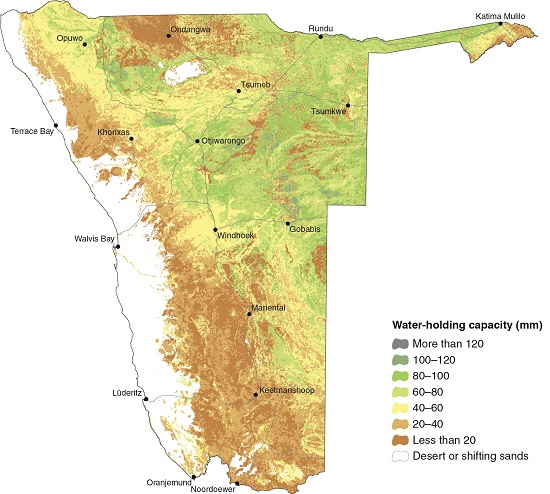
A host of factors affect how much water is available to support plant growth. These include rainfall; the infiltration of rainwater into the soil; the ability of water to rise through capillary action from the groundwater; how much water the soil can hold; and the depth to which roots can penetrate the soil. The effective rooting depth depends on the texture and various chemical properties of soil and the presence or absence of soil compaction, cemented layers and bedrock. In short, the amount of water available to plants is complex!
This map displays the amount of water (in millimetres) that could be available in the root zone of plants. In this case, it was calculated for maize because it is a widely grown staple. The available water capacity is lowest in the southern, western and central-northern regions of Namibia, while the capacity is greatest in the deep sands found in the northeast. Areas shown in white do not have soils suitable for any form of agriculture.
5.16 Organic carbon content

Organic matter is an essential component of soils, consisting of living organisms (plant roots, fungi, bacteria and burrowing animals) and dead, decaying and decomposed plant and animal material. It contains, among others, cellulose, lignin, lipids, starches, proteins and charcoal – all molecules with a carbon backbone. Organic carbon makes up about half of all the organic matter in the soil, and provides energy for organisms, supports and stabilises soil, increases water retention, stores and supplies nutrients, and enhances a soil's ability to suppress pests and diseases.
Other than higher concentrations in alluvial soils in the northeast and patchy occurrences elsewhere, most Namibian soils have little organic carbon. This is largely due to Namibia’s hot and arid climate and low plant biomass production.
5.17 Water-holding capacity and organic carbon content of soils in Africa
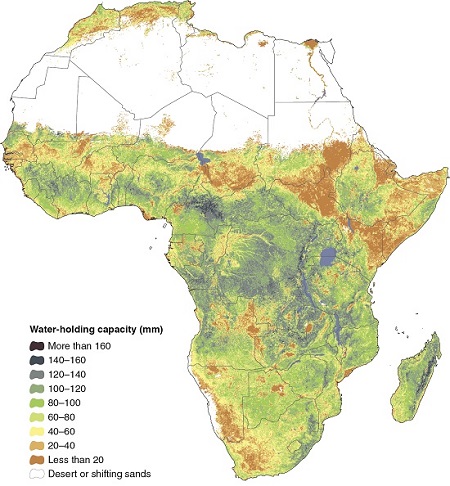
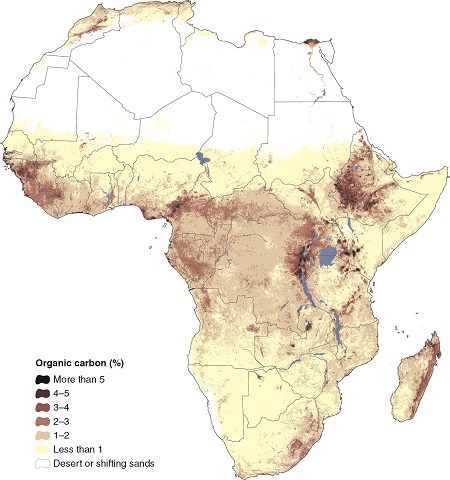
Compared with certain other parts of Africa and many parts of the world, Namibia's soils are extremely poor, as shown here using the examples of available water-holding capacity in the root zone5 and the organic carbon content of soils.6 Areas on the maps coloured white do not have functional soils.

Photo: JB Dodane
Soils at lower elevations are often deeper, and thus able to support more and bigger plants with deeper roots than at higher elevations where the soils are shallow and the ground beneath is very rocky.

Photo: J Mendelsohn
Typical Namibian yields of smallholder crops, such as sorghum, millet (locally known as mahangu) and maize, are the lowest in Africa as a result of poor waterholding capacity, low organic carbon and other constraints, such as the availability of phosphorus and nitrogen, and the cation exchange capacity. High evaporation rates, low, erratic rainfall, and pests are additional limiting factors. Crop farming in Namibia is not easy!

